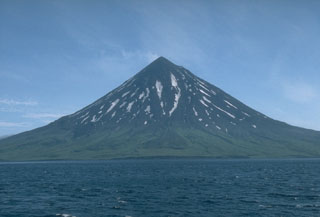Report on Cleveland (United States) — 13 April-19 April 2016
Smithsonian Institution / US Geological Survey
Weekly Volcanic Activity Report, 13 April-19 April 2016
Managing Editor: Sally Sennert.
Please cite this report as:
Global Volcanism Program, 2016. Report on Cleveland (United States) (Sennert, S, ed.). Weekly Volcanic Activity Report, 13 April-19 April 2016. Smithsonian Institution and US Geological Survey.
Cleveland
United States
52.825°N, 169.944°W; summit elev. 1730 m
All times are local (unless otherwise noted)
AVO reported an explosion at Cleveland at 1058 on 16 April was detected by both infrasound (air pressure) and seismic data. AVO raised the Level of Concern Color Code to Orange and the Volcano Alert Level to Watch. Seismicity decreased to background levels within an hour of the explosion. Satellite views the next day were obscured by clouds below 9.1 km (30,000 ft) a.s.l.; no signs of ash had been detected above that altitude.
Geological Summary. The beautifully symmetrical Mount Cleveland stratovolcano is situated at the western end of the uninhabited Chuginadak Island. It lies SE across Carlisle Pass strait from Carlisle volcano and NE across Chuginadak Pass strait from Herbert volcano. Joined to the rest of Chuginadak Island by a low isthmus, Cleveland is the highest of the Islands of the Four Mountains group and is one of the most active of the Aleutian Islands. The native name, Chuginadak, refers to the Aleut goddess of fire, who was thought to reside on the volcano. Numerous large lava flows descend the steep-sided flanks. It is possible that some 18th-to-19th century eruptions attributed to Carlisle should be ascribed to Cleveland (Miller et al., 1998). In 1944 it produced the only known fatality from an Aleutian eruption. Recent eruptions have been characterized by short-lived explosive ash emissions, at times accompanied by lava fountaining and lava flows down the flanks.
Source: US Geological Survey Alaska Volcano Observatory (AVO)

